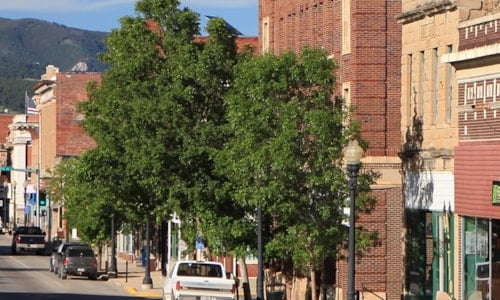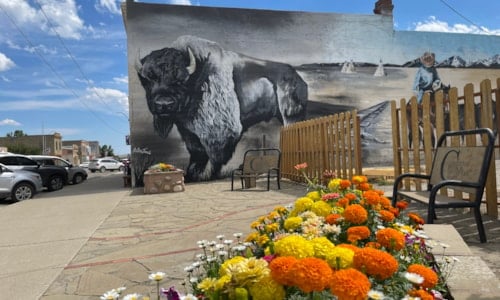
Upper Missouri River Breaks National Monument
Lewistown, Montana
About Upper Missouri River Breaks National Monument
Carved by ancient seas, shifting continents, and the relentless flow of the mighty Missouri River, the Upper Missouri River Breaks National Monument is a landscape millions of years in the making. This vast, untamed expanse of rugged badlands, towering white cliffs, and winding river valleys is more than just scenic—it’s a living storybook of the Earth’s deep past.
Long before Lewis and Clark charted this wild terrain, Cretaceous-period dinosaurs roamed its floodplains. Their fossils still lie buried beneath The Breaks’ dramatic cliffs and badlands. Today, the 377,000-acre monument protects 149 miles of the Missouri’s Wild and Scenic Corridor, preserving a landscape that has remained largely unchanged for centuries.
The best time to explore The Breaks is from late spring through early fall, when weather conditions are favorable and river levels are ideal for floating. While some areas are accessible by gravel road, much of the monument is only accessible by water or trail. Many access roads are gravel or unimproved, and high-clearance vehicles are recommended. Cell service is limited, so bring printed maps and let someone know your plans. Whether you’re planning a multi-day float or a scenic drive, recreate responsibly and follow Leave No Trace principles to help preserve this fragile and remote ecosystem.
Start your visit in Fort Benton, MT, at the Upper Missouri River Breaks Interpretive Center. Here, BLM staff provide maps, trip planning tips, and insight into the area’s ecology and history. Throughout the season, local outfitters host guided trips, river cleanups, birding events, and educational programs to help visitors experience The Breaks more meaningfully.
The most iconic and best way to experience The Breaks is by floating the Missouri River. Paddlers can launch from Coal Banks Landing and drift through the legendary White Cliffs section, where wind-sculpted rock formations rise dramatically above the river. Peaceful campsites dot the route, and interpretive signs along the way share the stories of those who once called this land home. Plan your float with a list of river access and launch points provided by the BLM here.
Prefer to stay on land? The Breaks offer miles of hiking trails, scenic overlooks, and wildlife viewing opportunities. The area is also a popular destination for hunting and fishing, with healthy populations of game and native fish.
Getting to the Upper Missouri River Breaks National Monument depends on where you're coming from and which part of this vast, rugged landscape you want to explore. The monument stretches over 149 miles along the Missouri River, beginning near Fort Benton on U.S. Highway 87 and ending at the Robinson Bridge crossing on U.S. Highway 191, near Lewistown. While Fort Benton is often listed as the gateway to the Breaks and is a popular launch point for river trips, Lewistown offers closer access to eastern sections of the monument. A map of The Breaks provided by the Bureau of Land Management can be found below.
Whether you’re floating past sandstone bluffs, casting a line, or spotting bighorn sheep along the cliffs, The Breaks deliver the kind of wild, unplugged adventure that defines Central Montana. The riverbanks are lined with historic campsites, Native American encampments, and remnants of steamboat travel, making every bend a story in motion. The monument is also teeming with wildlife, home to elk, deer, bald eagles, and even grizzly bears have been spotted returning to the plains.
The Breaks invite you to slow down, take it in, and connect with a place that feels both timeless and alive. In a world that moves fast, The Breaks offer something rare: a wild, sacred stillness that stays with you long after you’ve gone.
Upper Missouri River Breaks National Monument Activities
Cultural
Heritage
History
Lewis And Clark
Photography
Upper Missouri River Breaks National Monument Amenities
Maps
Upper Missouri River Breaks National Monument Reservations
Season
All Year
About Upper Missouri River Breaks National Monument
Carved by ancient seas, shifting continents, and the relentless flow of the mighty Missouri River, the Upper Missouri River Breaks National Monument is a landscape millions of years in the making. This vast, untamed expanse of rugged badlands, towering white cliffs, and winding river valleys is more than just scenic—it’s a living storybook of the Earth’s deep past.
Long before Lewis and Clark charted this wild terrain, Cretaceous-period dinosaurs roamed its floodplains. Their fossils still lie buried beneath The Breaks’ dramatic cliffs and badlands. Today, the 377,000-acre monument protects 149 miles of the Missouri’s Wild and Scenic Corridor, preserving a landscape that has remained largely unchanged for centuries.
The best time to explore The Breaks is from late spring through early fall, when weather conditions are favorable and river levels are ideal for floating. While some areas are accessible by gravel road, much of the monument is only accessible by water or trail. Many access roads are gravel or unimproved, and high-clearance vehicles are recommended. Cell service is limited, so bring printed maps and let someone know your plans. Whether you’re planning a multi-day float or a scenic drive, recreate responsibly and follow Leave No Trace principles to help preserve this fragile and remote ecosystem.
Start your visit in Fort Benton, MT, at the Upper Missouri River Breaks Interpretive Center. Here, BLM staff provide maps, trip planning tips, and insight into the area’s ecology and history. Throughout the season, local outfitters host guided trips, river cleanups, birding events, and educational programs to help visitors experience The Breaks more meaningfully.
The most iconic and best way to experience The Breaks is by floating the Missouri River. Paddlers can launch from Coal Banks Landing and drift through the legendary White Cliffs section, where wind-sculpted rock formations rise dramatically above the river. Peaceful campsites dot the route, and interpretive signs along the way share the stories of those who once called this land home. Plan your float with a list of river access and launch points provided by the BLM here.
Prefer to stay on land? The Breaks offer miles of hiking trails, scenic overlooks, and wildlife viewing opportunities. The area is also a popular destination for hunting and fishing, with healthy populations of game and native fish.
Getting to the Upper Missouri River Breaks National Monument depends on where you're coming from and which part of this vast, rugged landscape you want to explore. The monument stretches over 149 miles along the Missouri River, beginning near Fort Benton on U.S. Highway 87 and ending at the Robinson Bridge crossing on U.S. Highway 191, near Lewistown. While Fort Benton is often listed as the gateway to the Breaks and is a popular launch point for river trips, Lewistown offers closer access to eastern sections of the monument. A map of The Breaks provided by the Bureau of Land Management can be found below.
Whether you’re floating past sandstone bluffs, casting a line, or spotting bighorn sheep along the cliffs, The Breaks deliver the kind of wild, unplugged adventure that defines Central Montana. The riverbanks are lined with historic campsites, Native American encampments, and remnants of steamboat travel, making every bend a story in motion. The monument is also teeming with wildlife, home to elk, deer, bald eagles, and even grizzly bears have been spotted returning to the plains.
The Breaks invite you to slow down, take it in, and connect with a place that feels both timeless and alive. In a world that moves fast, The Breaks offer something rare: a wild, sacred stillness that stays with you long after you’ve gone.
Upper Missouri River Breaks National Monument Activities
Cultural
Heritage
History
Lewis And Clark
Photography
Upper Missouri River Breaks National Monument Amenities
Maps
Upper Missouri River Breaks National Monument Reservations
Season
All Year
About Lewistown, Montana

Lewistown sits at the geographic center of Montana. Originally a mining town and now largely agricultural, Lewistown captures both the rural and artistic nature of Montana. Known as the City of Stone, the original settlers were Croatian stone masons. Beautiful architecture constructed by early... ...
Learn More about Lewistown












